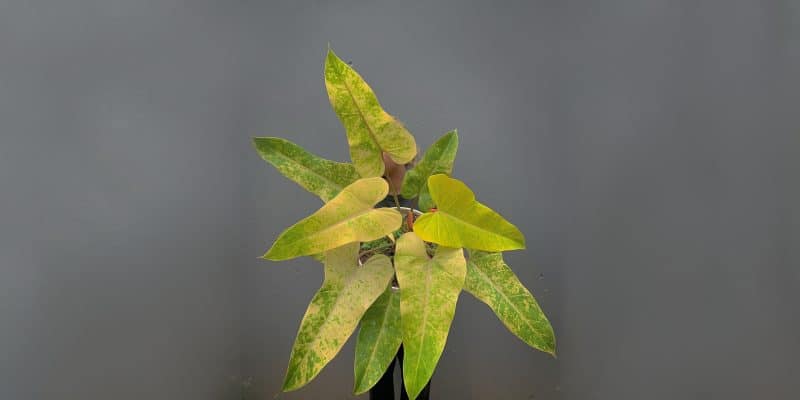Nature’s masterpiece, the Philodendron Painted Lady, has a painterly blend of colors unlike any other plant.
From its beautiful foliage with brushstrokes of green, pink, and cream to its wild trailing vines, Philodendron Painted Lady is a sight to behold.
We’re going to dive right into the world of Philodendron Painted Lady care, exploring everything you need to know about this tropical plant. We’ll cover the conditions it prefers, propagation, and how to deal with the most common issues that come up.
Table of Contents
Philodendron Painted Lady Plant Care Guide
History, Habitat, and Characteristics
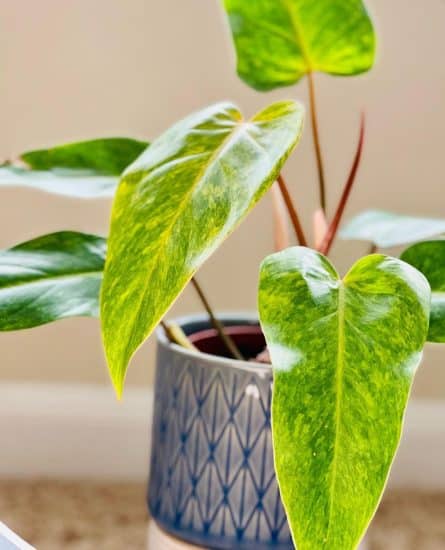
Philodendron Painted Lady (Philodendron erubescens ‘Painted Lady’) hails from Central and South America, mainly Columbia, where it’s at home in the understory of the rainforest canopy. Its heart-shaped leaves are a medley of green, creamy white, and pink blush, and the stems feature eye-catching shades of red, peach, and pink.
The Painted Lady is an epiphytic plant in the Araceae family, which means it grows on the surface of other plants using aerial roots. Grown indoors, Philodendron Painted Lady needs proper support to climb upwards and produce larger leaves.
Fun fact: The Philodendron Painted Lady is a hybrid of the Philodendron erubescens ‘Emerald Queen’ plant and the Philodendron erubescens ‘Burgundy’ plant.
Light
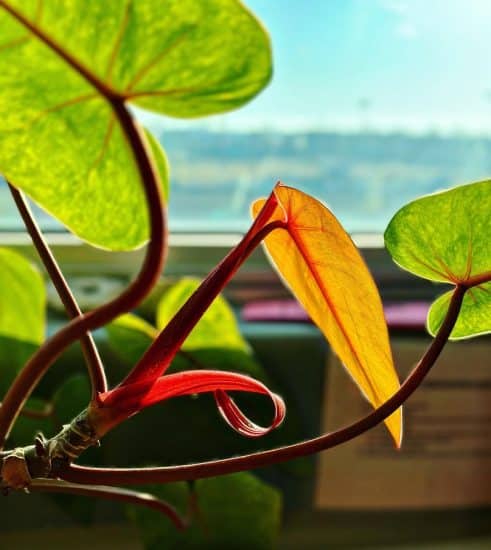
For best results, provide your Philodendron Painted Lady with approximately 8 hours of bright, indirect sunlight per day.
An north- or east-facing window is ideal for avoiding direct sunlight, which can scorch its delicate leaves. To capitalize on the more consistently direct light from a west- or south-facing window, use a sheer curtain to diffuse the light and protect your plant.
Of course, not everyone has a plethora of big windows in their home. If natural light is scarce, don’t panic — grow lights can step in as a suitable substitute to meet your plant’s needs.
If your plant isn’t receiving enough light, you’ll notice slow growth and lackluster leaves. On the other hand, if your plant receives too much direct light, you may observe leaf burn and yellowing, wilting leaves.
Water
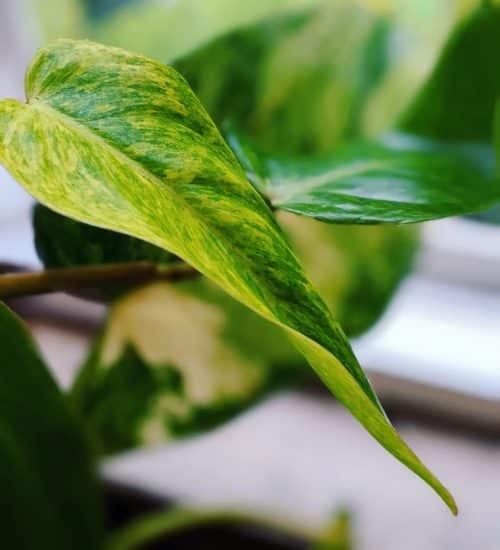
During the growing season (spring to summer), water Philodendron Painted Lady when the top 1 or 2 inches of soil have gone dry. With larger plants, let the soil go 25% dry before watering. During the dormant season (fall and winter), it’s best to water when the soil is 50% dry.
Drooping, limp leaves are a telltale sign that your Philodendron Painted Lady plant is not getting enough water. If you notice these signs, feel the soil and water if it’s dry. If your Painted Lady gets a lot of sun, it may need more water than recommended. But be sure to avoid overwatering.
If your Painted Lady Philodendron is getting too much water, you may notice yellowing leaves, mushy stems, and persistently moist soil. In this case, it’s essential to let the soil dry out before watering again. Overwatering is the most common way to kill a houseplant.
Our watering tips:
- Allow the soil to go 25% dry during spring and summer, and 50% dry during its dormant season.
- You’ll know you’ve given your plant enough water when it flows from the bottom drainage holes.
- Use filtered or distilled water where possible to avoid a buildup of chemicals and minerals in the soil.
Temperature and Humidity
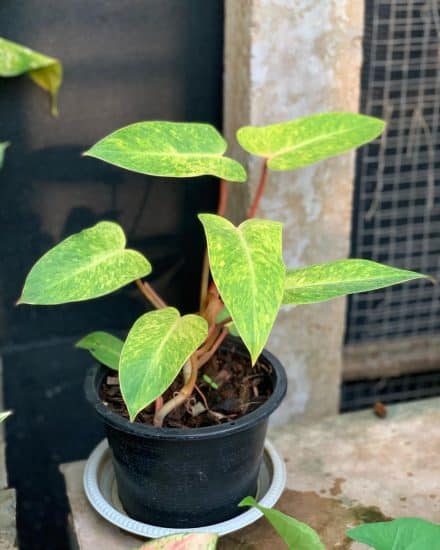
Ideal conditions for Philodendron Painted Lady include a consistent temperature range of 65-80°F (18-27°C). These tropical plants are sensitive to cold drafts or sudden changes in temperature, so keep them away from windows or doors during chilly seasons. If you need to move your plant during colder months, make sure to cover it properly for protection.
However, it’s also important to avoid temperatures that are too high. If you notice wilting leaves and all other aspects of your care routine are on point, the temperature might be too high. Keep your Philodendron Painted Lady out of direct sun and away from radiators or heating vents.
To mimic the humid rainforest conditions of a native Philodendron Painted Lady, maintain an average humidity between 40% and 60%. Drooping leaves or crispy brown edges could indicate too little humidity, while too much humidity may cause yellowing leaves and potential fungal infections.
To raise humidity:
- Set your plant on a tray filled with pebbles and water. Keep in mind the pot should not touch the water, just sit atop wet pebbles.
- Group multiple houseplants together to share moisture through transpiration.
- Place a humidifier nearby to increase the overall humidity in the room and promote air circulation.
- Avoid misting philodendron plants. Instead, clean them occasionally with a damp cloth to remove accumulated dust or potential pests, like spider mites.
Soil and Planting
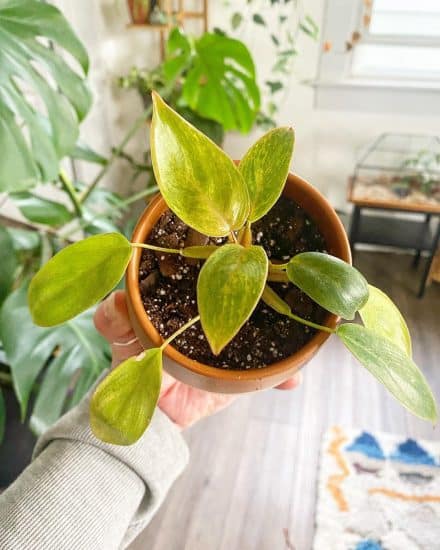
The ideal Philodendron Painted Lady soil is a well-draining, chunky soil mix that retains moisture without overwhelming the roots.
To create your own aroid mix at home, combine one part houseplant soil, one part orchid bark or coco coir (an eco-friendly alternative to sphagnum moss or peat moss), and one part perlite (or another material that enhances drainage). A top-notch mix consists of 60% fresh potting soil, 30% perlite, and 10% orchid bark or coco coir.
Repotting
Don’t repot your Philodendron Painted Lady until it’s outgrown its pot. You can tell by checking the drainage holes for roots peeking out, or gently lifting the plant out of its pot. If roots are visible along the outside of the soil, your plant is ready to be repotted.
When selecting a pot, opt for a ceramic or terracotta container with at least one drainage hole — good drainage is crucial to keeping the plant’s roots healthy. Choose a pot that’s a few inches wider and higher than the last one, but don’t go too big — this can lead to too much soil and overwatering.
Provide your Philodendron Painted Lady plant with a structure to grow up, such as a moss pole, a plank of wood, or a gardening stick. This not only prevents the plant from flopping over but also encourages larger leaf growth.
Fertilizing
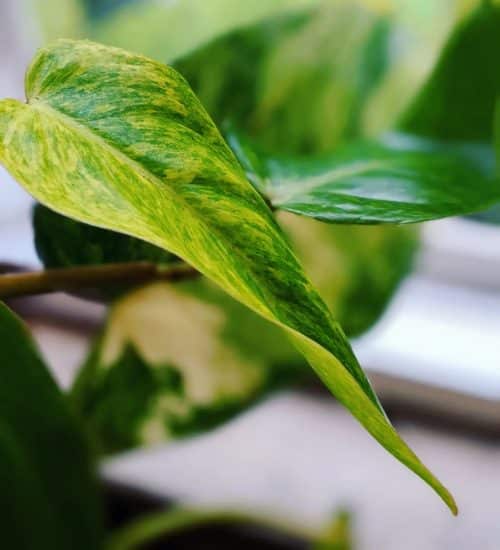
Fertilizing your Painted Lady plant during its active growing phase (spring through summer) is essential for optimal growth. Use a balanced houseplant fertilizer, such as a 10-10-10 or 20-20-20 formula, and follow the manufacturer’s instructions.
In the summer, fertilize the plant every 4-6 weeks. In the winter, Philodendron Painted Lady may go partially dormant. It’s best to omit fertilizing entirely during this time. Because the plant grows slowly during the winter, it won’t take up the fertilizer and you’ll just be wasting money. What’s worse, fertilizing in winter can harm your plant!
Watch out for signs of over-fertilization, like leaf burn, yellowing leaves, or a sudden drop of leaves. If you notice any of these issues, flush the soil with water to remove excess fertilizer and scale back on the frequency of fertilization.
Propagation

Propagating Philodendron Painted Lady is an easy way to multiply your plants and share them with friends (and trust me, they’re gonna want this one!).
Propagating Philodendron Painted Lady by stem cuttings:
- Snip a healthy stem: On the mother plant, pick a stem with several leaves and a node. Using clean, sterilized gardening shears, cut the stem just below the node, so you have a 4-6-inch-long cutting.
- Coat the cut end with rooting hormone: After making your cut, dip the end in a commercial rooting hormone to encourage root growth.
- Pick your propagation medium: You can root your Philodendron Painted Lady cutting in different mediums, including coco coir, perlite, LECA (lightweight expanded clay aggregate), or water. Whichever medium you choose, make sure it’s moist but not soaking wet.
- Plant the cutting: Now, insert the cut end into your chosen medium, ensuring the node is in contact with the damp medium.
- Keep it humid and watch for roots: Put your cutting in bright light but out of direct sun, and keep humidity high by covering the container with a plastic bag or dome. In a few weeks, new roots should start to grow from the node.
- Time for some weak fertilizer: Once you see initial roots and secondary rootlets, feed your cutting a diluted slow-release fertilizer to encourage faster growth.
- Move it to a new home: When the roots look healthy and well-established, it’s time to transplant your cutting into a small pot with well-draining potting soil. Continue to provide it with proper watering and light exposure.
Common Issues

Philodendron Painted Lady plants can encounter a few common issues, but we’ll help you recognize and solve them.
Slow Growth
Philodendron Painted Lady is known for its moderate growth speed, which might not suit those who prefer faster-growing plants. A slowdown in growth could be due to insufficient light or inadequate nutrients.
Check the plant’s location and ensure it gets plenty of bright, indirect light throughout the day. Additionally, nourish your plant with a well-balanced, slow-release fertilizer every 4-6 weeks during its active growing season (spring and summer).
It’s essential to cut back on fertilizing during winter months, since excessive fertilization in low light and cooler conditions can cause problems like leggy growth or poor root development.
Leaf Burn

Leaf burn on your Philodendron Painted Lady, manifesting as unsightly brown spots or yellow patches on the leaves, is often caused by direct sunlight. To recognize this issue, look for signs of sunburn — browning or yellowing that start at the leaf’s edge and spread inward.
To rectify this situation, move your plant to a brighter spot with filtered light, making sure to avoid direct sun exposure that can damage its foliage. If your plant already resides in a location with indirect light, consider adding a shade cloth or moving it a bit farther from the window to diffuse the light and prevent future leaf burn.
Pests and Diseases
The Philodendron Painted Lady plant is generally a hardy tropical plant, perfect for growing indoors. However, all indoor plants encounter some common issues . . . and common issues have common solutions!
Root Rot
Have you noticed yellowing leaves, a wilted appearance, or an unpleasant smell coming from the soil of your Philodendron Painted Lady? This could be a sign of root rot, which usually happens when you’ve overwatered a plant or provided poor drainage. Here’s what to do:
- Gently take your plant from its pot and check the roots. If you see black, slimy, or mushy roots, trim them away with sterilized scissors.
- Assess your pot’s drainage. If it’s lacking, repot your plant in a well-draining pot to prevent future issues.
- Use a fresh potting mix with perlite or pumice mixed in for better aeration and drainage.
- Allow the soil to dry out before watering again using the soak-and-dry method, and avoid letting your plant sit in standing water.
Mealybugs
Mealybugs are tiny white, cotton-like specks that appear on a plant’s leaves and stems. They feed on the plant’s sap, causing leaves to yellow or even drop off.
Here’s how to get rid of these unwelcome visitors:
- First, separate your affected plant from other houseplants to stop the mealybugs from spreading.
- Using a cotton swab dipped in rubbing alcohol, gently dab and remove the mealybugs from your plant.
- Mix water and a few drops of dish soap, then spray it onto your plant, focusing on the affected areas.
- Rinse the soapy solution off your plant after a few hours to keep it clean and healthy.
- Keep a close eye on your plant for several weeks, ensuring the mealybugs are gone for good.
Conclusion

That’s a wrap for our Philodendron Painted Lady care guide!
This beautiful plant truly is a living work of art, bringing color, vibrancy, and joy to any space it inhabits. With its showstopping variegated leaves and relatively low-maintenance care requirements, it’s easy to see why the Philodendron Painted Lady is a hit — it’s museum-worthy!
Philodendron Painted Lady care summary:
- Bright, indirect light is ideal.
- Avoid direct sunlight, which can cause leaf burn.
- Maintain a temperature range of 65-80°F (18-27°C) and humidity between 40% and 60%.
- Use a well-draining, aroid soil mix and a container with proper drainage.
- Feed with a balanced, houseplant fertilizer during the growing season.
- Propagate through stem cuttings to share this masterpiece with friends and fellow plant lovers.
We hope you now have a wealth of knowledge to help your Philodendron Painted Lady thrive. If you found this guide helpful, don’t hesitate to share it, and feel free to reach out with any questions or concerns.
Here’s to a flourishing Philodendron Painted Lady!
FAQ
Is Philodendron Painted Lady rare?
While the Philodendron Painted Lady may not be as common as some other houseplants, it’s certainly not the rarest of the bunch. However, it might be a tad harder to find than the usual suspects in your local nursery or plant shop.
Don’t be disheartened if you can’t find it immediately. You can often track it down online or through specialty plant retailers. Just be sure to do your research and buy from a reputable source to ensure you receive a healthy and ethically sourced specimen.
Is Painted Lady Philodendron a climber or crawler philodendron?
The Philodendron Painted Lady distinguishes itself as a climbing species among philodendron plants. It produces long aerial roots that, in nature, search for something to cling to — a tree trunk or rock, for example. Providing your Painted Lady plant with a moss pole or other support will encourage its climbing habit.
Do Painted Ladies revert?
The Philodendron Painted Lady is not known for reverting to a regular Philodendron erubescens, even though it’s a hybrid of the Emerald Queen and Burgundy philodendrons. The stunning coloration and unique foliage pattern you love should stay consistent as long as your Painted Lady plant receives the right care.
However, poor tropical plant care, such as insufficient lighting, can cause the leaves to appear dull or lose their distinctive appearance. To maintain the vibrancy of your Painted Lady Philodendron, just remember to provide the right balance of bright, indirect sunlight (or a grow light, if necessary) and be attentive to its other basic care needs.
Does Philodendron Painted Lady flower?
Philodendron Painted Lady can produce flowers, but they;re quite rare and usually not the main attraction of this stunning plant. The flowers appear as a white, elongated spadix, surrounded by a green-white spathe. While it’s uncommon for this plant to bloom indoors, following a few easy tips could increase the likelihood!
First and foremost, ensure your Philodendron Painted Lady is thriving overall. Providing the ideal temperature range, maintaining the right humidity levels (between 40% and 60%), and placing the plant in bright indirect sunlight will create a comfortable environment.
This plant really needs access to a sufficient amount of bright light, which helps your Philodendron Painted Lady build up the energy necessary for producing flowers.
Is Philodendron Painted Lady toxic?
Philodendron Painted Lady is considered toxic by the ASPCA. As gorgeous as this plant may be, its beauty comes with a warning. Be cautious if you have curious pets or young children around.
The leaves of Philodendron Painted Lady contain calcium oxalate crystals, an irritant that shouldn’t be ingested. If you do keep this plant, consider placing it somewhere inaccessible to children and pets (like on a high shelf or in a hanging basket). It’s also a good idea to educate your household members about the potential risks and keep an eye on curious plant explorers to prevent any mishaps.

